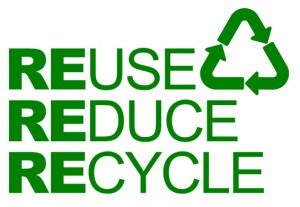Vehicle emissions contributing to climate change. Electricity production causing global warming. El Niño threatening stronger storms and coral bleaching. Oceans full of plastics and landfills overflowing with waste. These are the ideas many of us have in our heads; skimming our newsfeeds, Twitter, or headlines, we’re made to think that the world is in a pretty sorry state, and there is nothing we can do to stop, let alone reverse any of the impacts of human activity on the planet. But it’s not all doom-and-gloom. Individuals do have the ability to take small steps to try and reduce their impact on the environment, and it can be a lot simpler than you might think. We’ve all heard the classic three Rs: Reduce, Reuse, Recycle’ mantra; now, there are some new concepts that you can embrace that will not only help the environment, but can save you money as well. By adding the concepts of ‘Repair, Refuse, Rethink” to your three Rs, you can make your impact on your local environment even more eco-friendly.
First, when confronted with an item in your home that no longer works, nowadays the tendency is to throw it out, go to your local big box store, and buy a new one. Landfills are full of lamps, toasters, bed linens, and other household items that simply get thrown out because they are broken, torn, or not working like they did when they were new. But what if they could be repaired? The internet is full of tutorials on how to mend clothes, fix household tools, and do basic repairs to everyday items. While any serious electronics work should be done by a licensed professional, there are plenty of everyday repairs that can be done that will prolong the life of household items.
Second, try your hand at refusing. Going to the shops for just a few small items? Refuse a bag, especially if it’s plastic. Or think about the next time you go to a big event, like a conference, concert, or council program. There’s usually a heap of flyers, brochures, cards, pamphlets, and other marketing and sales material that people usually take, glance at, and then throw away. You can refuse to take these items unless you really need them, and can try to find these materials that incorporate recycled materials. This is especially true of fast food and take-away menus—many of these eateries now have apps and menus online, so you don’t need the clutter of a stack of menus and coupons.
Lastly, you can rethink your daily activities and how your habits affect your local environment, including the possibility of upcycling used goods into new products. Ideas include using a magnifying glass and shoe box to turn a mobile phone into a rudimentary projector; how to use tin foil to make too small batteries fit correctly and how to turn a bottle of water into a lamp. Thinking outside the box can make old materials come to new life, and can save you a lot of money. One standout idea is to take old coffee jars and upcycle them: they can be filled with dried fruit, spices, dried pasta, or other goods and be used as storage, or filled with candles, seashells, or small items such as keys and buttons to make a cheap, interesting decoration for a bookshelf or table. Got an old laptop bag? Try turning it into a picnic hamper. The possibilities are endless.
So the next time you are about to throw out an old item, or are about to pick up a take-away menu, or are wondering what to do with that old Tupperware container, think about the three new Rs—repair, refuse, and rethink. In addition to reduce, reuse and recycle, you will have some great approaches and reducing your impact on the environment, as well as some great ways to save a bit of money.
Remember: We’ve got one planet; let’s take care of it!

